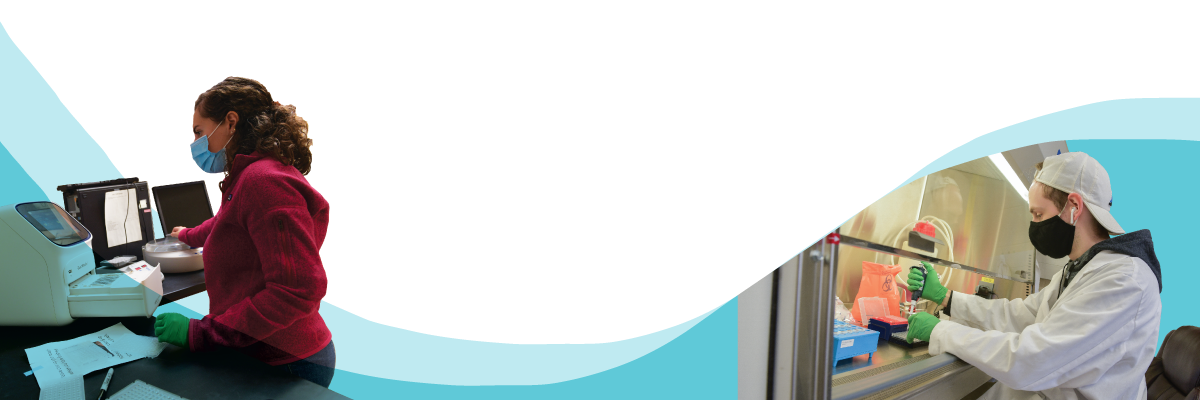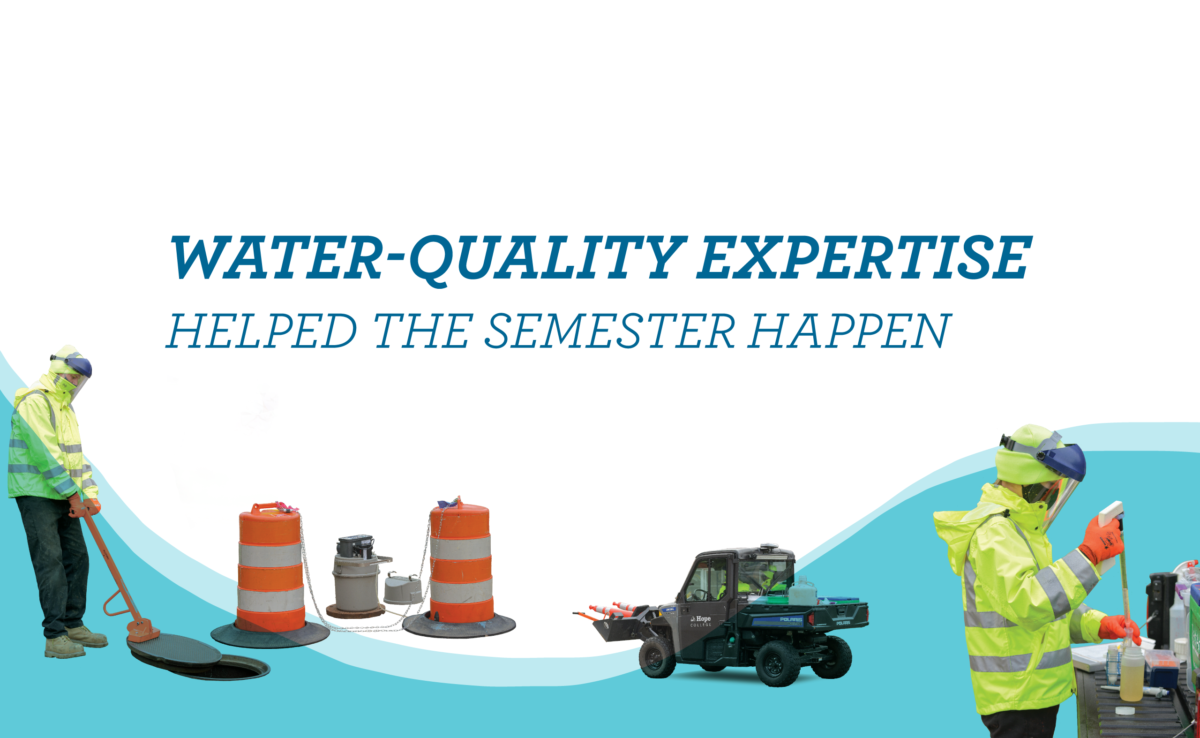Water-Quality Expertise Helped the Semester Happen
Among all the firsts that 2020 brought, here’s something no one saw coming: Hope College staffers parked in campus intersections, opening maintenance holes to get to the sewage below. Six mornings a week, rain or shine.
They are the front-line workers in the college’s wastewater surveillance program, which since August has kept tabs on COVID-19 levels in what’s flushed and washed down drains in residence halls.
It is part of Hope’s multi-pronged approach to keeping the campus safe during the pandemic, and came together thanks to a constellation of resources that’s unusual for a school like Hope: science faculty with specialties in water quality, virology and microbiology, plus a lab already equipped for ongoing, long-term water quality research.
“We had the right types of equipment, we had faculty with the right sets of expertise, and we had recent graduates who had come up through some of our active programs on environmental monitoring. That allowed us to tap into the research quickly,” said microbiologist Dr. Aaron Best, one of four Hope faculty who lead the wastewater testing program.
The broad goal of Hope’s combined strategies this fall — testing at home of every student before the semester, daily random testing of students and wastewater testing — was to inform administrators’ decisions about how best to maintain a safe, healthy campus community. The wastewater component proved so effective that the college will be placing even more emphasis on it going forward and eliminate the random testing (which experience has shown that it essentially renders redundant).
“You really want the data to be actionable,” Best added. “This is really not a research project approach to things; this is a production level approach. You have to make decisions with the best available information you have, and see if it helps. And it has.”
In addition, if wastewater analysis detects an elevated level of the virus in a particular section of campus, it sets in motion immediate testing of all the students living in that zone.
Each time that occurred, the full testing of students in the zone identified a number of asymptomatic cases. For example, Best related, early in the semester testing produced “a reasonably high detection, and so it concerned us. We recommended everybody in the dorm be tested. The testing team was able to bring everyone over to DeVos Fieldhouse and run them through the test that night. We caught five cases we wouldn’t have caught otherwise, or till later — prior to when they even would have approached getting symptoms.”
“This is really not a research project approach to things; this is a production level approach. You have to make decisions with the best available information you have, and see if it helps.
And it has.”

Once those active cases are removed from the zone — that is, when students who tested positive are isolated in a separate location on campus — and contact tracing and quarantine occur, testing indicates a drop in the level of virus in the wastewater from that zone, he added.
Collecting samples of sewage is less messy than it sounds, although members of the team note that on warm days it can be whiffy. Ick factor notwithstanding, it’s effective: just as infected individuals may “shed” virus as they breathe and talk, they may shed virus in urine and feces, too.
For sampling purposes, the faculty leading the wastewater surveillance project — Best, chemists Dr. Michael Pikaart and Dr. Brent Krueger, and virologist Dr. Benjamin Kopek (see pages 18-19) — divided the college into nine residential zones. Between 200-250 students live in each one. In each zone, wastewater flows from all the residence halls and cottages into the same sewer main, so a sample taken from a single existing utility port provides data about the entire zone.
In masks, gloves and neon yellow safety vests and hats, the wastewater sampling team sets off each morning in a golf cart and a tiny utility truck with lights flashing and golf flag flying. They use a magnetic cover lifter to open utility shafts and then reach in by hand or with a hook to haul up auto-samplers installed near the top of the shafts, from which clear, flexible tubing extends down into open trenches of sewage far below.
Heading up the crew is Randall Wade ’16, who majored in three sciences and now directs the chemistry lab for Day 1, Hope’s program that vaults freshmen into scientific research. Working alongside are interns Hope hired to staff this project: Amy Olgers ’20 and Daniel Wade ’20, who both majored in geology and environmental science and came onboard in August; and Schuylar Brunink ’20 (biology major) and Kyle Ross ’20 (biochemistry and molecular biology major), who started in mid-October.
“A lot of the techniques we’re using now are the same as the ones we learned for research projects as students, so I really felt like I knew what I was doing even when we were just starting.
In an even more general sense, a lot of research is about troubleshooting and problem-solving, and having already experienced that has made it a lot easier to adapt to brand-new projects like this and get things up and running smoothly.”
The white plastic auto-samplers resemble beer kegs in size and shape. A power unit on each one’s cover pumps in 130 milliliters of fluid every 20 minutes. Each morning, each unit contains 72 samples that it collected during the previous 24 hours. Traveling through an early-October day with Olgers and the Wade brothers (Brunink and Ross hadn’t yet joined the project) provides a chance to see the process unfold. With a long, battery-powered mixing tool, Danny Wade blends the contents, pours some into a smaller container he hands off to Olgers, and then tips the rest back down the open hole. On the back of the utility truck, Olgers pours 40 milliliters into each of three vials and adds salt and a buffer substance to preserve and stabilize the samples so lab analysis will produce an accurate count. She labels and packs the vials; Wade drops the mixing tool into a bucket of bleach solution and covers the maintenance hole; and they’re off to the next stop on their 90-minute route.
In Best’s laboratory at the A. Paul Schaap Science Center, they pasteurize the contents of each vial to inactivate any virus that may be present in the sample. They filter out solids and then capture and clean RNA on a silica filter column, Randy Wade explained.
Then they perform a quantitative polymerase chain reaction, adding enzymes and running the material through cycles of heat that copy and amplify the RNA. The PCR results are computer-generated and computer-read.

It’s heady stuff, but not for the recent grads working as interns. All four participated in research as students at Hope, and Olgers and Wade both were engaged in water quality research specifically. “I worked in the same lab space under mostly the same supervision and on similar projects — water quality studies — as a student, so I was already familiar with the procedures and protocols that we use in the lab on a daily basis,” Danny Wade said.
“A lot of the techniques we’re using now are the same as the ones we learned for research projects as students,” Olgers agreed, “so I really felt like I knew what I was doing even when we were just starting. In an even more general sense, a lot of research is about troubleshooting and problem-solving, and having already experienced that has made it a lot easier to adapt to brand-new projects like this and get things up and running smoothly.”
Concurrent with the team’s daily lab procedures, two miles north testing is also underway at Trident Laboratories, a toxicology lab owned by Dr. Matthew Rycenga ’06. Part of each morning’s samples are delivered to Trident for processing there. In March, as COVID testing exploded on the scene, the college loaned instrumentation to Rycenga that has proved valuable for his firm’s parallel testing to back up results obtained on campus.
Finally, around the dinner hour, the evening shift takes over. At home, Best pulls up onscreen the results of that day’s lab work. He analyzes the data and sends a summary to Kopek, who reviews it and makes a nightly recommendation to the testing subcommittee of the college’s COVID-19 Steering Committee. Best and Kopek look for elevated levels of deactivated SARS-CoV-2 virus — even slightly high readings that indicate that one or more individual in a particular zone of campus may be shedding the virus.
“We know we can detect it. The challenge is to able to correctly interpret it,” Best said. Infected individuals have varying levels of the virus within them, and it’s unclear how much virus any one person may contribute to the wastewater. “They may be shedding at different levels as they move through their infection; each one of us behaves differently.”
The college’s efforts are expanding beyond the Hope community.
All along, in addition to samples collected on campus the college lab has been testing two wastewater samples that Holland city workers collect each morning at the input lines of the municipal sewage treatment facility and deliver to the science center.
Since Oct. 1, Hope’s wastewater surveillance team also has been part of a pilot project of Michigan’s Department of Environment, Great Lakes & Energy (EGLE) to coordinate testing labs’ procedures, detection methods and reporting so data can be monitored on a statewide level and used predictively. EGLE has purchased equipment for participating labs, some of which were just starting up wastewater testing. Hope College received digital PCR instrumentation capable of more sensitive detection of what’s in sewage. Best said he and his colleagues are interacting with the public health departments of Ottawa County and Allegan County and have begun monitoring the wastewater treatment plants in nearby Zeeland and Allegan.


One thought on “Water-Quality Expertise Helped the Semester Happen”
Comments are closed.